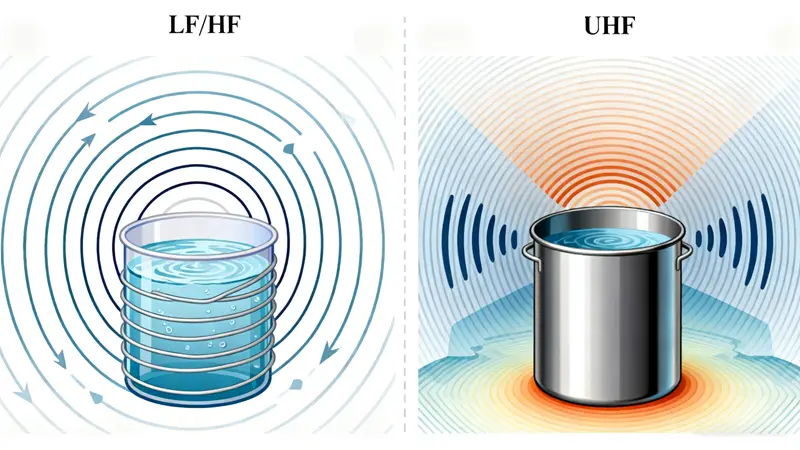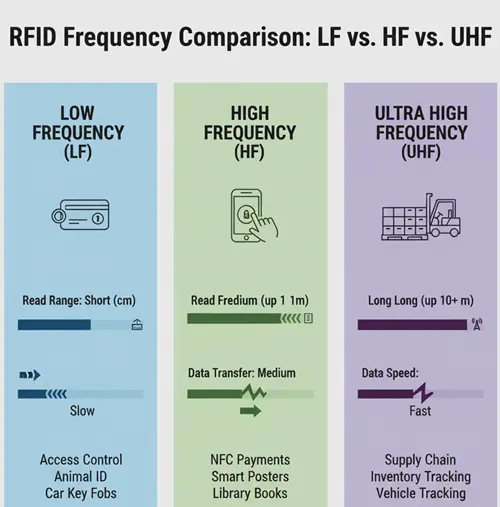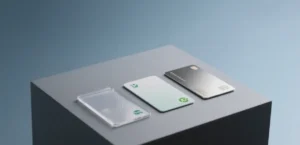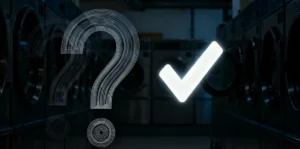
RFID Frequency Comparison: LF vs. HF vs. UHF
Custom Your RFID Cards
Frequency Bands Reflect Physical Constraints
Passive RFID tags harvest energy from the reader field. The coupling method—inductive (near-field) or radiative (far-field) depends on frequency and dictates system behavior:
- LF and HF use inductive coupling. Energy transfer occurs via magnetic fields between coiled antennas. Range is short but robust against water and metal.
- UHF uses radiative coupling. Tags reflect and modulate incident RF waves (backscatter). Range and throughput increase, but performance degrades near conductive or high-dielectric materials.
Band selection is a trade-off between range and environmental resilience.

Low Frequency (LF): 125–134 kHz
Operation
LF relies on tightly coupled magnetic induction. Energy transfer decays with the cube of distance, limiting range.
Advantages
- Penetrates water, tissue, and non-ferrous materials with <3 dB attenuation.
- Functions in high-EMI environments (e.g., near welders, motors).
- Read range ≤10 cm prevents unauthorized interrogation.
Limitations
- Read range: 2–10 cm.
- Data rate: ≤1 kbps (ID-only payloads).
- Antenna size: ≥40 mm coil diameter for card form factor.
Applications
- Livestock ear tags (ISO 11784/85). Subcutaneous implantation remains feasible due to tissue penetration.
- Industrial access control in humid or oily environments (e.g., automotive plants, cold storage).
- Tracking medical equipment near MRI or sterilization units.
High Frequency (HF): 13.56 MHz
Operation
HF uses resonant inductive coupling. Range extends to ~1 m with optimized antenna design.
Advantages
- Global ISM band (no licensing).
- Strong standardization: ISO/IEC 14443 (MIFARE), ISO/IEC 15693, NFC Forum.
- Supports cryptographic authentication (e.g., ISO 14443-4).
Limitations
- Requires ferrite or foam isolation on metal surfaces.
- Data rate: ≤106 kbps.
- Anti-collision supports ~20 tags simultaneously (ISO 15693).
Applications
- Corporate ID badges (access, time/attendance, payment).
- Transit fare cards (e.g., OMNY, Clipper).
- Library item tracking (shelf-level reads without line-of-sight).
- NFC-enabled product authentication (smartphone interaction).

Ultra-High Frequency (UHF): 860–960 MHz (RAIN RFID)
Operation
UHF uses far-field radiation and backscatter modulation per EPCglobal Gen2 (ISO/IEC 18000-63).
Advantages
- Read range: 6–12 m (fixed readers), 5–8 m (handheld).
- Throughput: >600 tags/second in dense deployments.
- Inlay cost: $0.05–$0.25 at 1M+ volume.
Limitations
- Water attenuates signal by 10–20 dB (e.g., read range drops 50–90% for produce or pharmaceuticals).
- Metal causes reflection and detuning; requires on-metal tag design or ≥5 mm air gap.
- Regional regulations differ (U.S.: 902–928 MHz; EU: 865–868 MHz).
Applications
- Warehouse pallet tracking (automated dock doors).
- Retail inventory counts (full-store scan in <10 minutes).
- Airline baggage handling (IATA Resolution 753 compliance).
- Surgical kit tracking from sterilization to OR use.

LF/HF/UHF Performance Comparison
| Parameter | LF | HF | UHF |
|---|---|---|---|
| Coupling | Inductive (near-field) | Inductive (near-field) | Radiative (far-field) |
| Read range | 2–10 cm | 0–100 cm | 1–12+ m |
| Data rate | ≤1 kbps | ≤106 kbps | ≥640 kbps |
| Metal operation | Direct mounting | Requires isolation | Requires on-metal tag or air gap |
| Water tolerance | <3 dB loss | 5–8 dB loss | 10–20 dB loss |
| Anti-collision | Sequential | ~20 tags (ISO 15693) | 100s–1000s/s (Gen2v2) |
| Key standards | ISO 11784/85 | ISO 14443, ISO 15693 | EPC Gen2 |
| Inlay cost (1M+) | $0.20–$0.80 | $0.15–$0.50 | $0.05–$0.25 |
Data and cost reflect 2025 U.S. commercial deployments.
Dual-Frequency Solutions
Single-band systems cannot satisfy simultaneous requirements for proximity security and wide-area tracking. Dual-frequency RFID cards, dual frequency RFID wristband or RFID tags integrate two ICs or IDs and antennas into one form factor.
Common Architectures
| Architecture | Value | Use Cases |
|---|---|---|
| LF + UHF | LF for secure access; UHF for location tracking | Livestock (LF health records, UHF herd positioning); facility credentials (LF door entry, UHF parking/fleet tracking) |
| HF + UHF | HF for user interaction; UHF for inventory | Retail labels (NFC loyalty, UHF stock count); pharma (HF pharmacy verification, UHF distribution) |
Engineering Constraints
- Antenna co-design: LF coils (≥40 mm) and UHF dipoles (~85 mm) must be isolated to prevent detuning. FEM simulation is required.
- Cost: Dual-IC tags cost 2.5–4× single-band UHF. Yield loss increases during lamination.
- Reader support: Requires time-multiplexed protocol polling (e.g., Impinj R700 + HF module). Middleware must link LF and UHF IDs to one asset.
Deploy dual-frequency only when process savings justify the cost premium—typically for high-value assets or critical credentials.
Selection Workflow
- Characterize the environment
- Water content >20% → Prioritize LF or HF.
- Metal-dominant surfaces → Evaluate on-metal UHF or HF with shielding.
- Define performance needs
- Range <10 cm, single-tag → LF
- Range 10–100 cm, user-initiated → HF
- Range >1 m or >50 tags/second → UHF
- Assess interoperability
- Legacy access systems → HF (14443/15693)
- GS1 supply chain → UHF (Gen2)
- Model TCO
Include reader infrastructure, site preparation, and labor—not just tag cost.
Outlook
- Single-die ICs (e.g., NXP ICODE DNA + UCODE 9xm) reduce dual-frequency size and cost.
- RF simulation tools (ANSYS, CST) enable predictive UHF deployment in metal-rich sites.
- Edge processing (e.g., reader-side filtering) reduces backend data load.
Physical trade-offs among LF, HF, and UHF remain fixed. Optimal system design aligns frequency choice with operational constraints—not vendor preference.


